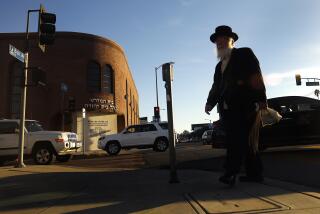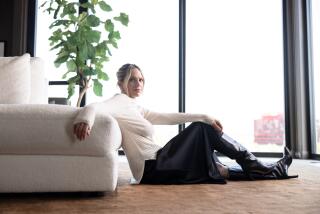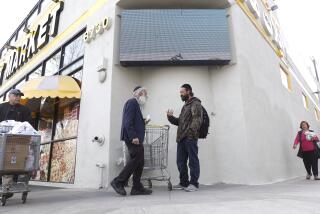New Rabbi Revives Fading Spirit of 70-Year-Old Synagogue
At one point in the early 1960s, Congregation Mishkon Tephilo fell on bad times. Many of its founders had died or moved away, much of the old Jewish neighborhood of Ocean Park was torn down for urban renewal and the rabbi and principal of the Hebrew school had left their jobs.
As membership dropped to fewer than 100 from a high of more than 500 in the 1940s, some synagogue leaders suggested selling the property, which lies just south of the Santa Monica-Los Angeles boundary in Venice.
“They wanted to move anyplace, anyplace away from the beach,” recalls Ruth Krieger, 70, at that time secretary in the synagogue office.
She and several others disagreed, however, and Krieger took it on herself to send a letter to the members “in my own words and with my own postage.”
‘Future Bright as Sunsets’
Despite the changes that racked the community, she wrote in 1964, “our future on Main Street is as bright as our sunsets over the horizon are beautiful. Now is not the time to run.”
Her appeal proved successful and the congregation hung on, although the sites that were cleared for urban renewal were not built on for years and the view from the steps of the olive-green sanctuary is still one of empty lots.
Despite that, and despite rabbis who did not speak English, or who left before their contracts were up, leaders of the congregation speak optimistically of the future as they prepare to celebrate what they believe is Mishkon Tephilo’s 70th anniversary.
They attribute the change in fortunes to the arrival in August, 1983, of Rabbi Dov Gartenberg, 31, a Honolulu native whose only previous experience in the pulpit was two years as an assistant rabbi for a congregation in the San Fernando Valley.
‘Got Young People Involved’
“He got all the young people involved,” said Rose Fragin, a member of the synagogue since her family moved to Ocean Park in 1929.
When her father’s generation passed away, she said, “there was no one to take over. The young ones strayed away. But now we’ve started to get a rabbi who is more aggressive, and we’ve found different ways of getting people more interested.”
Gartenberg speaks warmly of the older generation.
“My philosophy is not to segregate along generational lines,” he said. “We don’t have singles groups or seniors groups or young marrieds. We encourage the younger generation to interact and learn from the people who have been here, to appreciate the quality of loyalty that the older generation has demonstrated.”
The synagogue’s founding date is unclear because records go back only to November, 1918, but old-timers say the first services were held for vacationers from Los Angeles on the Jewish New Year in the early fall of 1914, making it one of the oldest congregations on the Westside.
The first rabbis were sent out from Wilshire Boulevard Temple, which is linked to the Reform movement, the most relaxed of Judaism’s three branches in its religious observances.
Preferred Orthodoxy
But they did not meet the needs of the Eastern European immigrants who settled in Ocean Park, and Mishkon Tephilo was incorporated in 1918 as an Orthodox congregation, with strict adherence to tradition and biblical law.
An early advertisement called for a rabbi who would “kill chickens, teach children in Hebrew and English and lead prayers for $100 a week and to read the Torah when needed.”
The reference to chickens reflected observant Jews’ requirement for kosher food--in this case, chickens slaughtered according to the dictates of the Bible.
Observant Jews also require sacramental wine for Sabbath evening and holiday meals, which apparently caused a scandal during Prohibition when synagogues were permitted to make their own wine despite the nationwide ban on alcohol.
“They couldn’t account for the amount of wine, and there were charges from the congregation that Gentiles somehow were getting hold of the wine,” according to Arnold Springer, a professor at California State University, Long Beach, who has been researching the synagogue’s archives for a history of Venice.
Intent on Jewish Education
Generally, he said, the archives reveal a “factious and rowdy” group but one that was always concerned with Jewish education. One of the synagogue’s first acts was to set up a Hebrew school.
Since much of the Jewish population in Venice was not religious, he said, “it would be a mistake to say that the temple was the source and focus of Jewish life in the bay area and that Jewish life revolved around the temple.”
Still, it served a vibrant community that lived within walking distance of the synagogue, along the streets that led to the beach and the Ocean Park pier.
Members of the congregation included Morris Hirsch, whose son, Mike, promoted boxing at the old Ocean Park Arena, and Ben and Beatrice Krasna, whose son, Norman, was a noted playwright and screenwriter.
Other members came from a range of occupations, from beachside resort operators to shopkeepers, optometrists and the wholesalers who supplied stuffed toys, balls and other goods for the amusement booths that served Ocean Park’s many tourists.
Services in Dance Hall
Before the current sanctuary was built in 1948, the congregation would rent a dance hall on the pier for the crowds that attended its holiday services.
It changed its affiliation to the middle-of-the-road Conservative variant of Judaism in 1952, but membership sagged in the 1960s and fluctuated in the 1970s.
At one point in the middle of the last decade a group of younger people headed by author Michael Medved played an active role in the congregation, bringing the membership to more than 200.
However, Medved said, despite what he called a “mini-plot” that made him president and put his supporters in 19 of 21 seats on the board of directors, the new administration was unable to agree on a new rabbi.
“In the process of trying to find a rabbi, the thing fell apart,” he said. “It was very ironic.”
Conflict Between Ages
Older members remember that time for the efforts that were made to introduce Orthodox traditions, such as a barrier to separate male and female congregants.
“Those young people wanted to go back to more traditional ways,” said Fran Kronick, 64, chairman of the synagogue’s 70th anniversary celebrations. “For me, coming from parents who wanted to be modern . . . sometimes it was just hard to swallow, as if our grandparents became resurrected or if you put it on the TV screen and the ghosts of the past came back and said you have to do it this way. That’s why there was a big rift.”
In the end, many from the younger group moved to the beachfront Bay Cities Synagogue, a strictly Orthodox congregation, and the membership of Mishkon Tephilo sank below 100 until Gartenberg’s arrival.
One sign of his success was the full house for holiday services last fall for the first time in more than a decade.
Gartenberg sums up his changes as trying to make the synagogue’s traditional Judaism accessible to newcomers through adult education classes in religion and Hebrew.
‘Extremely Intimidating’
“If you don’t have a traditional background, it can be extremely intimidating,” he said.
He also introduced women into roles historically played by men, such as reading from the Scriptures and leading prayers.
Some of the older men found this difficult to accept at first, Gartenberg said, “but they’ve learned to live with it.”
As a new generation of Jews began moving in, he said, the traditional synagogue members--families with school-age children--were largely replaced by single people, single-parent families and young couples with infants.
“My strategy has been to create an outreach program for adults who would not normally join a synagogue, who become active not just for the children, because a lot of them don’t have children, but are looking for community,” Gartenberg said.
One of the appeals of Mishkon Tephilo, he said, is that it has never lost the haimish (Yiddish for homey) charm of an immigrant synagogue.
Like ‘Traditional Style’
“It never became a suburban synagogue. . . . That type of synagogue is not what people are looking for now,” he said. “People like the traditional style and format.”
While he also teaches in the afternoon Hebrew school and doubles as a cantor to lead the singing during Sabbath services, Gartenberg, unlike the rabbis of the 1920s is not required to slaughter chickens.
“The issue for that generation was becoming Americans, whereas many people coming to the synagogue now are Americans, and the issue for them is becoming Jewish,” he said.
One of the recent arrivals is Barbara Blake, 31, who joined the congregation in the fall of 1983.
“What attracted me was the rabbi and his approach to Judaism, which is basically that you can live a Jewish life in a modern American society,” she said.
“People feel very good there. There’s a spirit and an excitement about Judaism. . . . He doesn’t give you easy answers, but just some guidance on where you can read and where you can learn, and how you can lead a Jewish life.”
The anniversary celebrations will begin with Friday evening services Feb. 15, when 70 veteran members of the synagogue will be honored and there will be a presentation of reminiscences collected for an oral history project.
Rabbi Samuel Sachs, who led the congregation from 1952 until retirement in 1964, will be honored the next day, and there will be dinner-dance Sunday evening.
Springer of Cal State Long Beach will speak on the history of the synagogue at Friday evening services Feb. 22.
More to Read
Sign up for Essential California
The most important California stories and recommendations in your inbox every morning.
You may occasionally receive promotional content from the Los Angeles Times.










